There is growing interest in installing photovoltaic systems in the middle of the forest. One reason is that there is plenty of available space. Another is that landowners can get more revenue streams and the possibility of higher returns than forestry provides.
Many of the solar parks in Sweden are built on arable land, even though this type of land represents a relatively small part of the country’s surface area. What there is a lot of, however, is forest – and there is great potential,” says Oskar Molin, project development manager at EnergiEngagemang.
– “While it is a bit more technically challenging to pile in forest land than in a field, given the need for new and clean energy production, I hope more people will start to see the potential of the forest,” he says.
He points out that there are several reasons why forest land and solar parks are a strong combination. For example, the lifespan of solar cells corresponds well with the long growth cycles of forests. A solar farm has an economic lifetime of at least thirty-five years.
– This long-term approach can be difficult to achieve in arable land, but it fits well with how forest owners plan their operations. At the same time, solar cells give the landowner a completely different cash flow than forestry,” he says.
Creating more revenue streams
In addition, the parks provide an economically useful complement to the forest owner’s other activities, as they do not require major investment and can be built on a leasehold basis.
– Leasing the land for a solar park provides a much higher return than the forest. In addition, the cash flow is spread evenly over the year instead of a lump sum at the final harvest. This gives you more legs to stand on and smooths out your income over the years.
To determine whether a forest parcel is suitable for this purpose, you need to look at the location, topography and any environmental and cultural values.
– But we take care of all that. We also manage the entire licensing process with the authorities and the contact with the network companies to investigate the connection possibilities.
Oskar Molin estimates that it takes an average of about five years from the first conversation with the landowner to the completion of the design and the start of construction of the park.
– The construction itself is going quite fast. It is the licensing process and contact with the network companies that takes a long time. But we never start any action on the ground until everything is ready. The landowner can also rest assured that we will never ask them to harvest anything until all permits are in place.
The right reimbursement model for each case
Once the park is up and running, EnergiEngagemang continues to take care of the service and maintenance contracts. The actual nature of the compensation varies from case to case.
– There is always the possibility to agree on the details of the level of compensation. Some landowners want a fixed rent per hectare per year to be sure of the income, some want a direct return on the park’s income, while others want an electricity contract. The important thing is to know that there are several different models, and that we are happy to help you find the most suitable one in each case,” says Oskar Molin.

